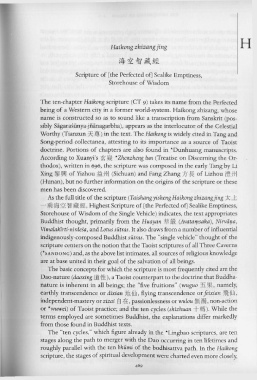Page 509 - The Encyclopedia of Taoism v1_A-L
P. 509
H
Haikong zhizangjing
Scripture of [the Perfected of] Sealike Emptiness,
Storehouse of Wisdom
The ten-chapter Haikong scripture (CT 9) takes its name from the Perfected
being of a Western city in a former world-system. Haikong zhizang, whose
name is constructed so as to sound like a transcription from Sanskrit (pos-
sibly Sagarasunya-jfianagarbha), appears as the interlocutor of the Celestial
Worthy (Tianzun 7( ~) in the text. The Haikong is widely cited in Tang and
Song-period collectanea, attesting to its importance as a source of Taoist
doctrine. Portions of chapters are also found in *Dunhuang manuscripts.
According to Xuanyi's ~ ~ *Zhenzheng lun (Treatise on Discerning the Or-
thodox), written in 696, the scripture was composed in the early Tang by Li
Xing ~~ of Yizhou :fiHH (Sichuan) and Fang Zhang 1J ~ of Lizhou ~j+1
(Hunan), but no further information on the origins of the scripture or these
men has been discovered.
As the full title of the scripture (Taishang yisheng Haikong zhizangjing j(...t
-* fflJ:£ I' ~ ~~ , Highest Scripture of [the Perfected of] Sealike Emptiness,
Storehouse of Wisdom of the Single Vehicle) indicates, the text appropriates
Buddhist thought, primarily from the Huayan ~.fiW: (Avata11tsaka), Nirva1).a,
Vimalaktrti-nirdesa, and Lotus sutras. It also draws from a number of influential
indigenously-composed Buddhist sutras. The "single vehicle" thought of the
scripture centers on the notion that the Taoist scriptures of all Three Caverns
(*SANDONG) and, as the above list intimates, all sources of religious knowledge
are at base united in their goal of the salvation of all beings.
The basic concepts for which the scripture is most frequently cited are the
Dao-nature (daoxing m '11), a Taoist counterpart to the doctrine that Buddha-
nature is inherent in all beings; the "five fruitions" (wuguo .li~, namely,
earthly transcendence or dixian it!!, {ill, flying transcendence or feixian m {ill ,
independent-mastery or zizai § tE, passionlessness or wulou ~ ~ , non-action
or *wuwei) of Taoist practice; and the ten cycles (shizhuan +,$). While the
terms employed are sometimes Buddhist, the explanations differ markedly
from those found in Buddhist texts.
The "ten cycles," which figure already in the *Lingbao scriptures, are ten
stages along the path to merger with the Dao occurring in ten lifetimes and
roughly parallel with the ten bhumi of the bodhisattva path. In the Haikong
scripture, the stages of spiritual development were charted even more closely,
469

